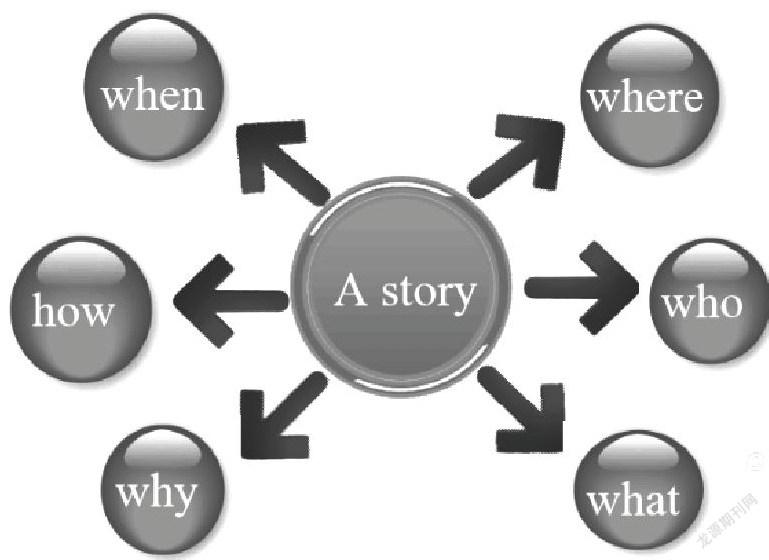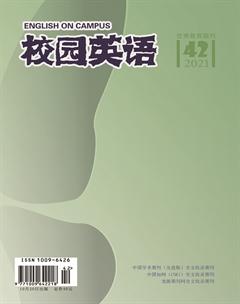基于讀思言模型高中英語讀后續寫教學初探

【摘要】黃遠振教授英語讀思言模型構念包括讀(閱讀、導讀、默讀、朗讀)、思(思考、思索、探究、交流)、言(表達、說和寫表達技能、說或寫的思維產品)。而高中英語讀后續寫是新高考的考試作文題型,以記敘文故事類文章或者夾敘夾議類文章為主,故事線索的邏輯性比較強。以讀促寫有意識地培養學生的創造性思維能力;以例導寫,讓學生有例可循,提高寫作能力。本文分析高中英語讀后續寫的要求,設計目的和評分標準,以一堂讀后續寫課為例,探究如何在高中英語教學中展開讀后續寫。提出教師應引導學生通讀文本,分析人物性格,確定故事的主要脈絡;結合續寫段落給定句子的開頭,確定故事走向;平衡文本中給定的畫線詞,確定故事情節;結合故事情節,升華主題。在此基礎上,揭開高中英語讀后續寫的奧秘。
【關鍵詞】讀思言;高中英語;讀后續寫;以例導寫
【作者簡介】黃志強,福建省泉州市泉州第六中學。
黃遠振教授的讀思言理論依據是閱讀學、思維學和語言學。本文主要解析如何利用“讀思言”+教學路徑,根據文本內容,聚焦“思”的設計:以“思”為著力點,提出個性化可操作方法。
首先,我們先來分析讀后續寫的考綱說明。提供一段350詞以內的語言材料,原文多是情節豐富的記敘文或者是夾敘夾議類文章,要求考生依據該材料內容、所給段落開頭語和所標示關鍵詞進行續寫(150詞左右),將其發展成一篇與給定材料有邏輯銜接、情節和結構完整的短文。
其次,我們一起來探究高中寫作新題型讀后續寫要考查學生什么能力。高中讀后續寫旨在以讀為輔,以寫為主,目標是學生的綜合語言運用能力,主要體現在四個方面:1.把握短文關鍵信息和語言特點的能力;2.語言運用的準確性和豐富性;3.對語篇結構的把握能力;4.創造性思維能力。
最后,我們一起來了解高考對讀后續寫的評分標準。第五檔作文(21-25):1.與所給短文融洽度高,與所提供各段落開頭語銜接合理;2.內容豐富,應用了5個以上短文中標出的關鍵詞語;3.所使用語法結構和詞匯豐富、準確,可能有些許錯誤,但完全不影響意義表達;4.有效地使用了語句間的連接成分,使所續寫短文結構緊湊。
那么,我們要怎么指導學生寫出高分作文?顯然要按照讀后續寫的評分標準,結合黃遠振教授的讀思言理念,在日常教學中著重訓練學生的 Reading(記敘文閱讀理解能力)、Thinking (由讀到寫的思維能力) 和 Writing(記敘文書面表達能力)。
接下來,筆者以自己的一節公開課為例,讀思言問題導向的讀后續寫,闡述如何以例導寫?并希望借此揭開高中英語讀后續寫的奧秘。
一、讀透材料,以例導寫
首先,大概用8分鐘到10分鐘的時間進行文本材料的閱讀,讀透了才能寫得好。
Beauty in Your Eyes
The park bench was deserted as I sat down to read beneath the long branches of an old willow tree. I was deserted. Endless quarrels with my family had left me nowhere to go but this desolate(荒涼的)corner of the park. As I sat on the bench, things happened recently began to flash through. Days seemed months to me recently. No cozy home to stay. No happy memories with family. No considerate family members to talk to. Even the book I was reading was no fun. Not content with life, I had a good reason to frown, for the world was intended to drag me down.
And if that weren't enough to ruin my day, a young boy out of breath approached me, all tired from play. He stood right in front of me with his head leaning down and said with great excitement, “Look what I found!” In his hand was a flower. What a pitiful sight, its petals(花瓣) were all worn——not enough rain, or too little light. He must have picked the flower from somewhere shady and sunless, just like where I was staying these days. I couldn’t help being self-pitying. Wanting him to take his dead flower away and go off to play, I faked a small smile and then looked away. “Why couldn't everyone just leave me be!” I thought to myself, upset and depressed.
But instead of leaving, he sat next to my side and placed the flower to his nose and declared loudly with certainty, “It sure smells pretty and it must be beautiful, too. That's why I picked it; here, it's for you.” The weed before me was dying or dead, not bright of colors, orange, yellow or red. But I knew I must take it, or he might never leave. So I reached for the flower, and replied, “Just what I need.” Again, instead of placing the flower in my hand, he held it mid-air without reason or plan. Curiosity drove me to look into his eyes. Blue as the sea, there is no color of light in his beautiful eyes.
續寫要求:1.所續寫短文的詞數應為150左右;2.至少使用5個短文中有下劃線的關鍵詞語;3.續寫部分分為兩段,每段的開頭語已為你寫好;4.續寫完成后,請用下劃線標出你所使用的關鍵詞語。
Paragraph 1
It was then that I noticed for the very first time that the boy could not see: he was blind.
Paragraph 2
For all of those times I myself had been blind towards the world around me.
首先,以讀思言的思維導圖的形式畫出記續文六要素。
接著,分析本文的故事情節。
The plot(情節)of the story
Who :The author; a blind boy
when :One day after quarrels with my family
Where:In a park ;on a deserted bench
What: I sat down on a bench to read
A boy gave me a dead flower
Why: He thought this flower was beautiful .
How: ?
Main idea: As I sat down on a deserted bench to read, a boy approached me and gave me a dead flower,which he thought was beautiful.
二、分析續寫的兩段首句,進行情節設定。在情節設定時,要邏輯合理,有多種選擇時,擇優而選,傳播正能量
第一段段首句分析與情節設定。
第一段首句:正是在那時我第一次意識到這個小男孩兒是盲人。
那么,當作者突然意識到小男孩兒是盲人的時候,她的情感發生什么變化?我們可以通過自己提出如下四個問題推動故事情節的發展。
Q1: How would I feel after knowing that the boy couldn't see?
Q2: What would I do with the boy's flower?
Q3: What would the boy do or say afterwards?
Q4: How would I feel about it?
第二段段首句分析與情節設定。
第二段首句:這些年來,我一直對我周圍的世界視而不見(“瞎”)。
同理,我們也還是走情感路線,自己提出如下三個問題:
Q1: Why would I say I was blind?
Q2: What would I learn from the little boy?
Q3: How would I feel about my life later?
三、透過文本材料的故事情節,續寫的結尾要進行主題升華
作者和家人在家里無休止地爭吵,心情壓抑,一個人獨自到公園里散心。但是內心的沮喪使她覺得周圍的環境也是一片荒蕪,內心的凄涼也使她無心讀書。甚至當盲人男孩兒拿著一朵花贈送給她的時候,她都覺得男孩子是在故意打擾自己。但是當作者發現男孩子是盲人的時候,花雖早已枯萎,但是男孩依然覺得很美。作者的內心起了巨大的波瀾。她終于意識到一切都是她自己的問題。真正“瞎”的是她的內心,導致自己忽略了生活中的美。在續寫部分,旨在通過學生的續寫內容升華文本,弘揚積極樂觀向上的生活態度,從而落實立德樹人根本任務,促進學生的德智體美勞全面發展。
四、范文參考
Paragraph 1:
It was then that I noticed for the very first time that the boy could not see: he was blind. I heard my voice trembling. Tears shone like the sun as I thanked him for picking the very best flower. “You're welcome”, he smiled, and then ran off to play, not realizing the impact he'd had on my day. I sat there and wondered how he managed to see a self-pitying woman beneath an old willow tree. How he know of my self-indulged plight(困境)?Perhaps he'd been blessed with true sight from his heart by God.
Paragraph 2:
For all of those times I myself had been blind towards the world around me. Through the eyes of a blind boy, at last I could see, the problem was not with the world; the problem was me. I decided and promised to see beauty and appreciate every second of my life. Then I held that dead flower up to my nose and breathed in the fragrance of a beautiful rose, smiling like that young boy. Another flower in his hand was about to change the life of an unsuspecting old woman.
綜上所述,“讀思言”的教學模式確實能夠在一定程度上提高學生的閱讀、思維和表達能力。“讀思言”+教學路徑,讓學生在實踐的過程中,能夠圍繞文本的要點來設計有效的問題,能夠更好地推動學生進行積極思考。學生在讀后續寫中,不但要有把握文章主題,理清文章脈絡的能力,還要良好的創造性想象思維能力,能構思故事情節,寫出符合邏輯的故事結尾,續寫文章時能擇優而選,傳播正能量,也因此能夠將其發展成一篇與給定材料有邏輯銜接、情節和結構完整的短文。
參考文獻:
[1]黃遠振,黃睿.英語深讀教學讀思言模型構念與實踐研究[J].福建基礎教育研究,2019(4):62-67.
[2]王慧涓.淺談讀后續寫提升學生閱讀及寫作能力[J].高考,2019 (5):127-128.
[3]胡潔元.讀后續寫的協同效應研究及應對策略[J].中小學外語教學(中學篇),2016(11):1-5.
[4]姜琳,陳錦.讀后續寫對英語寫作語言準確性、復雜性和流利性發展的影響[J].現代外語,2015(3):366-375,438.
[5]王敏,王初明.讀后續寫的協同效應[J].現代外語,2014(4):501-502.

